1994 PONTIAC GRAND-AM engine
[x] Cancel search: enginePage 180 of 274

Engine Oil
If the CHECK OIL light on the
instrument panel comes on,
it means you
need to check your engine oil level right
away. For more information, see “Check
Oil Light”
in the Index. You should check
the engine
oil regularly; this is an added
reminder.
It’s a good idea to check your engine oil
every time you get fuel. In order to get an
accurate reading, the oil must be warm
and the vehicle must be on level ground.
Turn off the engine and give the oil a few
minutes to drain back into the oil pan.
If
you don’t, the oil dipstick might not show
the actual level.
To Check Engine Oil
Pull out the dipstick and clean it with a
paper towel or cloth, then push
it back in
all the way. Remove it again, keeping the
tip lower, and check the level.
When to Add Oil
If the oil is at or below the ADD line, then
you’ll need to add some oil. But
you must
use the right kind. This section explains
what kind of oil
to use. For crankcase
capacity, see “Capacities and
Specifications” in the Index.
Adding Engine Oil
Just fill it enough to put the level
somewhere
in the proper operating range.
Push the dipstick all the way back
in
when you are through.
NOTICE:
Don’t add too much oil. If your
engine has
so much oil that the oil
level gets above the cross-hatched
area that shows the proper operating
range, your engine could
be
damaged.
179. . .
ProCarManuals.com
Page 181 of 274

.
Service & Appearance Care
What Kind of Oil to Use
3eginning midyear 1993, oils of the
)roper quality for your vehicle will be
dentified with this new “starburst”
;ymbol. The “starburst” symbol indicates
hat the
oil has been certified by the
imerican Petroleum Institute
(API), and
s preferred for use in your gasoline
‘ngine.
(ou should look for this on the front of
he oil container, and use only oils that
lisplay this new symbol.
(ou should also use the proper viscosity
Iil for your vehicle, as shown in the
ollowing chart:
I 80
Recommended SAE Viscosity
Grade Engine Oils
For best fuel economy and cold starting,
select the lowest
SAE viscosity grade oil
for the expected temperature range.
HOT
WEATHER
LOOK FOR
ONE OF THESE
LABELS
SAE 5W-30 PREFERRED
COLD
WEATHER
IF NEITHER SAE 5W-30 NOR SAE low-30
GRADE
OILS ARE AVAILABLE, SAE 30
GRADE MAY BE USED AT TEMPERATURES
ABOVE
40 DEGREES F (4 DEGREES C).
ANOTHER GRADE OIL NOT RECOMMENDED.
DO NOT USE SAE 1OW-40, SAE 2OW-50 OR
4s shown in the chart, SAE 5W-30 is best
or your vehicle. However,
you can use
;AE 1OW-30 if it’s going to be 0°F
- 18 “C) or above. These numbers on an
)il container show its viscosity, or
hickness.
Do not use other viscosity oils,
uch as
SAE low-40 or SAE 20W-50.
ProCarManuals.com
Page 182 of 274
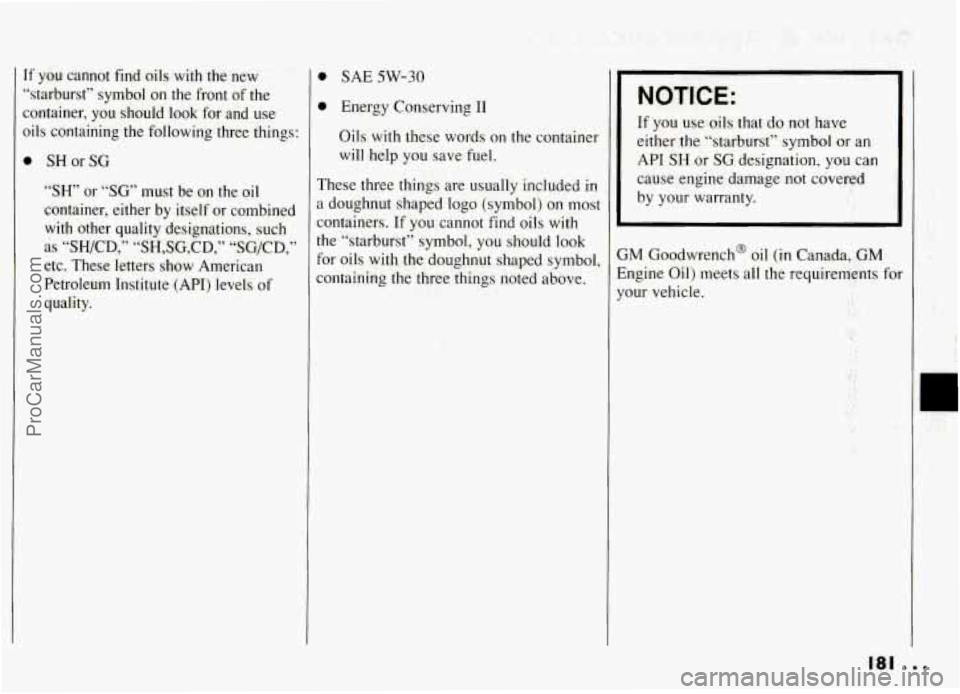
If you cannot find oils with the new
“starburst” symbol on the front of
the
container, you should look for and use
oils containing the following three things:
0 SHorSG
“SH” or “SG” must be on the oil
container, either by itself or combined
with other quality designations, such
as
“SH/CD,” “SH,SG,CD,” “SG/CD,”
etc. These letters show American
Petroleum Institute (API) levels of
quality.
0 SAE 5W-30
e Energy Conserving I1
Oils with these words on the container
will help you save fuel.
These three things are usually included in
a doughnut shaped logo (symbol) on most
containers. If
you cannot find oils with
the “starburst” symbol, you should
look
for oils with the doughnut shaped symbol,
containing the three things noted above.
NOTICE:
If you use.oils that do not have
either
the “starburst” symbol or an
API SH or SG designation, you can
cause engine damage not covered
by your warranty.
GM Goodwrench@ oil (in Canada, GM
Engine Oil) meets all the requirements for
your vehicle.
181 ...
ProCarManuals.com
Page 183 of 274
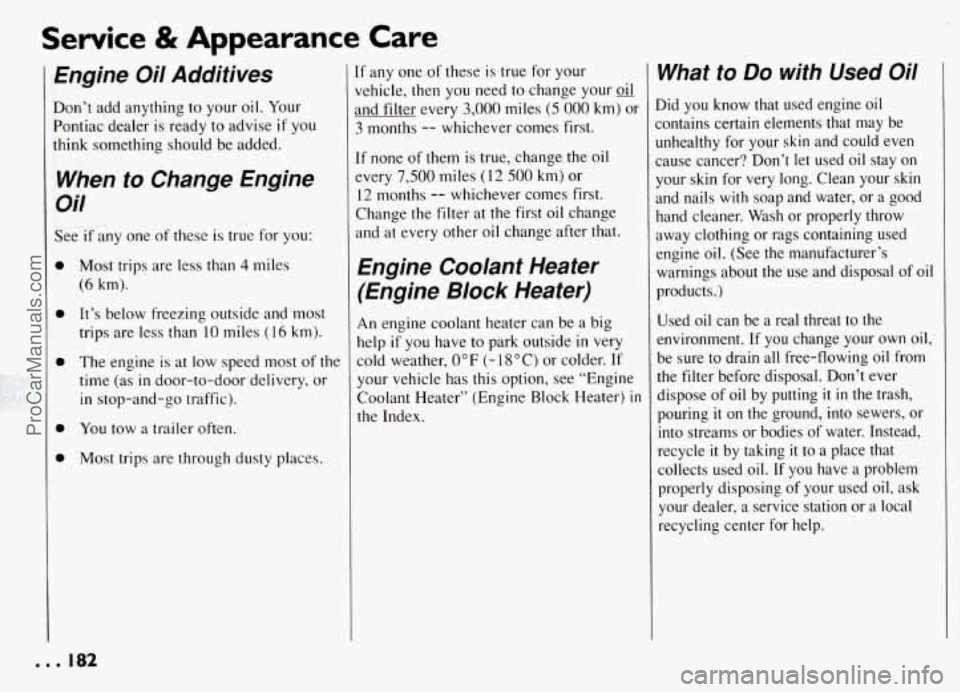
Service & Appearance Care
Engine Oil Additives
Don’t add anything to your oil. Your
Pontiac dealer is ready to advise
if you
think something should be added.
When to Change Engine
Oil
See if any one of these is true for you:
Most trips are less than 4 miles
(6 km).
It’s below freezing outside and most
trips are less than
10 miles ( 16 km).
The engine is at low speed most of the
time (as
in door-to-door delivery, or
in stop-and-go traffic).
You tow a trailer often.
Most trips are through dusty places.
[f any one of these is true for your
Vrehicle, then you need to change your oil
md filter every 3,000 miles (5 000 km) or-
3 months -- whichever comes first.
[f none of them is true, change the oil
=very 7,500 miles (12 500 km,) or
12 months -- whichever comes first.
Change the filter at the first oil change
and at every other
oil change after that.
Engine Coolant Heater
(Engine Block Heater)
An engine coolant heater can be a big
help if
you have to park outside in very
cold weather,
0°F (- 18OC) or colder. If
your vehicle has this option, see “Engine
Coolant Heater” (Engine Block Heater)
in
the Index.
What to Do with Used Oil
lid you know that used engine oil
:ontains certain elements that may be
Inhealthy
for your skin and could even
:awe cancer? Don’t let used oil stay on
your skin for very long. Clean your skin
md nails with soap and water, or a good
land cleaner. Wash or properly throw
lway clothing or rags containing used
mgine oil. (See the manufacturer’s
warnings about the use and disposal of oil
products.)
Used oil can be a real threat to the
mvironment.
If you change your own oil,
be sure to drain all free-flowing oil from
the filter before disposal. Don’t ever
dispose of oil by putting
it in the trash,
pouring
it on the ground, into sewers, or
into streams or bodies of water. Instead,
recycle
it by taking it to a place that
collects used
oil. If you have a problem
properly disposing of your used oil, ask
your dealer, a service station or
a local
recycling center for help.
... 182
ProCarManuals.com
Page 184 of 274
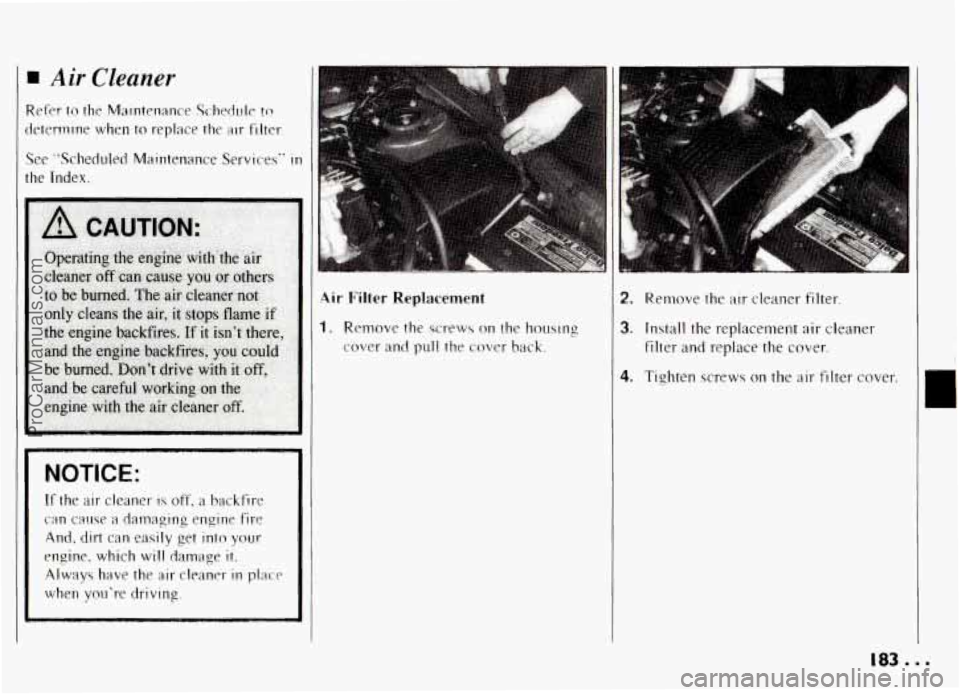
Air Cleaner
!der to the Maintenance Schedule tn
etemrne when to replace the 311- filter
;ee “‘Scheduled Maintenance Services“ in
?e Index. ~ ~~
NOTICE:
~ ~~~
If
the air cleaner is off, a backfire
can cause a damaging engine fire
And, dirt can easily get
into your
engine, which will damage it.
Always have the air cleaner in placp
when you’re driving.
Air Filter Replacement
1. Remove the screws on the housing
cover and pull the cover back.
2. Remove the air cleaner filter.
3. Install the replacement air cleaner
filter and replace the cover.
4. Tighten screws on the air filter cover.
183...
ProCarManuals.com
Page 185 of 274
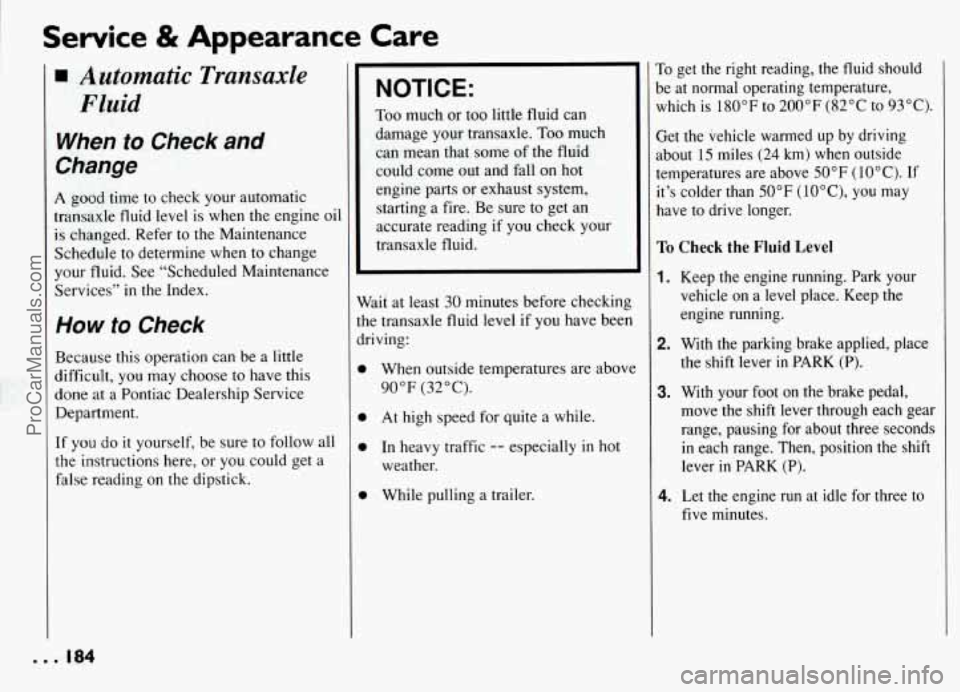
Service & Appearance Care
Automatic Transaxle Fluid
When to Check and
Change
A good time to check your automatic
transaxle fluid level is when the engine oil
is changed. Refer to the Maintenance
Schedule to determine when to change
your fluid. See “Scheduled Maintenance
Services” in the Index.
How to Check
Because this operation can be a little
difficult, you may choose
to have this
done at a Pontiac Dealership Service
Department.
If you do it yourself, be sure to follow all
the instructions here, or you could get a
false reading on the dipstick.
NOTICE:
Too much or too little fluid can
damage your transaxle.
Too much
can mean that some of the fluid
could come out and fall on hot
engine parts or exhaust system,
starting a fire. Be sure
to get an
accurate reading if you check your
transaxle fluid.
Wait at least 30 minutes before checking
the transaxle fluid level
if you have been
driving:
0 When outside temperatures are above
90°F (32°C).
0 At high speed for quite a while.
0 In heavy traffic -- especially in hot
weather.
0 While pulling a trailer.
To get the right reading, the fluid should
,e at normal operating temperature,
which is 180°F to 200°F (82°C to 93°C).
Set the vehicle warmed up by driving
ibout 15 miles
(24 km) when outside
iemperatures are above
50°F (10°C). If
it’s colder than 50°F
(IOOC), you may
have to drive longer.
To Check the Fluid Level
1. Keep the engine running. Park your
vehicle on a level place. Keep the
engine running.
2. With the parking brake applied, place
the shift lever in PARK (P).
3. With your foot on the brake pedal,
move the shift lever through each gear
range, pausing for about three seconds
in each range. Then, position the shift
lever in PARK
(P).
4. Let the engine run at idle for three to
five minutes.
ProCarManuals.com
Page 186 of 274
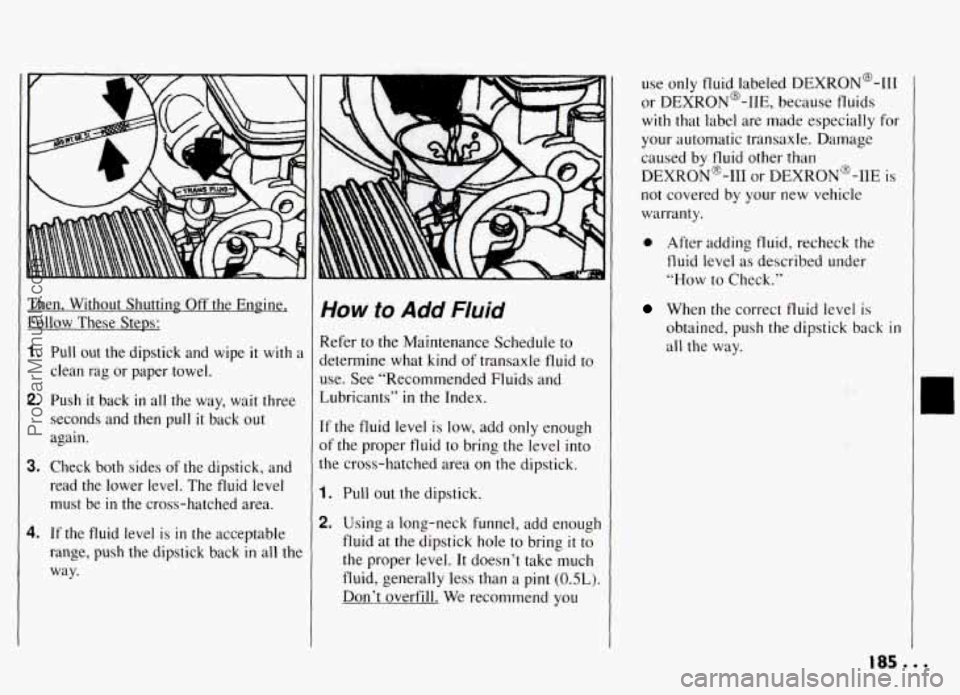
Then, Without Shutting Off the Engine,
Follow These Steps:
1. Pull out the dipstick and wipe it with a
clean rag or paper towel.
2. Push it back in all the way, wait three
seconds and then
pull it back out
again.
3. Check both sides of the dipstick, and
read the lower level. The fluid level
must be
in the cross-hatched area.
4. If the fluid level is in the acceptable
range, push the dipstick back in all the
way.
How to Add Fluid
Refer to the Maintenance Schedule to
determine what kind
of transaxle fluid to
use. See “Recommended Fluids and
Lubricants”
in the Index.
[f the fluid level is low, add only enough
of the proper fluid to bring the level into
the cross-hatched area on the dipstick.
1. Pull out the dipstick.
2. Using a long-neck funnel, add enough
fluid at the dipstick hole to bring it to
the proper level. It doesn’t take much
fluid, generally less than a pint
(OSL).
Don’t overfill. We recommend you
use only fluid labeled DEXRON@-111
or DEXRON@-IIE, because fluids with that label are made especially for
your automatic transaxle. Damage
caused by
fluid other than
DEXRON@-111 or DEXRON@-IIE is
not covered by your new vehicle
warranty.
0 After adding fluid, recheck the
fluid level as described under
“How
to Check.”
When the correct fluid level is
obtained, push the dipstick back in
all the way.
,. .. .. . ?!;i
.. !f ;
. : .
:,$ t * L .. ,, , ,, i
I85
ProCarManuals.com
Page 187 of 274

I Service & Appearance Care
Manual Transaxle
Fluid
When to Check
A good time to have it checked is when
the engine
oil is changed. However, the
tluid
in your manual transaxle doesn't
require changing.
How to Check
Because this operation can be a little
diftlcult,
you may choose to have this done
at a Pontiac Dealership Service Department.
If you do it yourself, be sure to follow a11
the instructions here, or you could get a
false reading on the dipstick.
NOTICE:
Too much or too little tluid can
darnage
your transaxle. Too much
can mean that some
of the tluid
could come out and fall
011 hot
engine parts or exhaust system,
starting a fire. Be sure
to get an
accurate reading
if you check your
transaxle fluid.
Check the tluid level only when your
engine IS off. the vehicle is parked on a
level place and the transaxle is
cool
enough for you to rest your fingers on the
transaxle case.
I
hen, Follow These Steps:
I Flip the handle up and the.n pull out
the dipstick and clean it with a rag or
paper towel.
2. Push it back in all the way and remove
It.
3. Check both sides of the dipstick and
read the lower level. The fluid level
must be between the
ADD and FULL
marks. (Note: Fluid may appear at the
bottom
of the dipstick even when the
tluid level is several pints low.)
4. If the tluid level is where it should be,
push the dipstick back in all the way
and flip the handle down. If the fluid
level is low. add more fluid as
described
in the next steps.
. .* 186
ProCarManuals.com